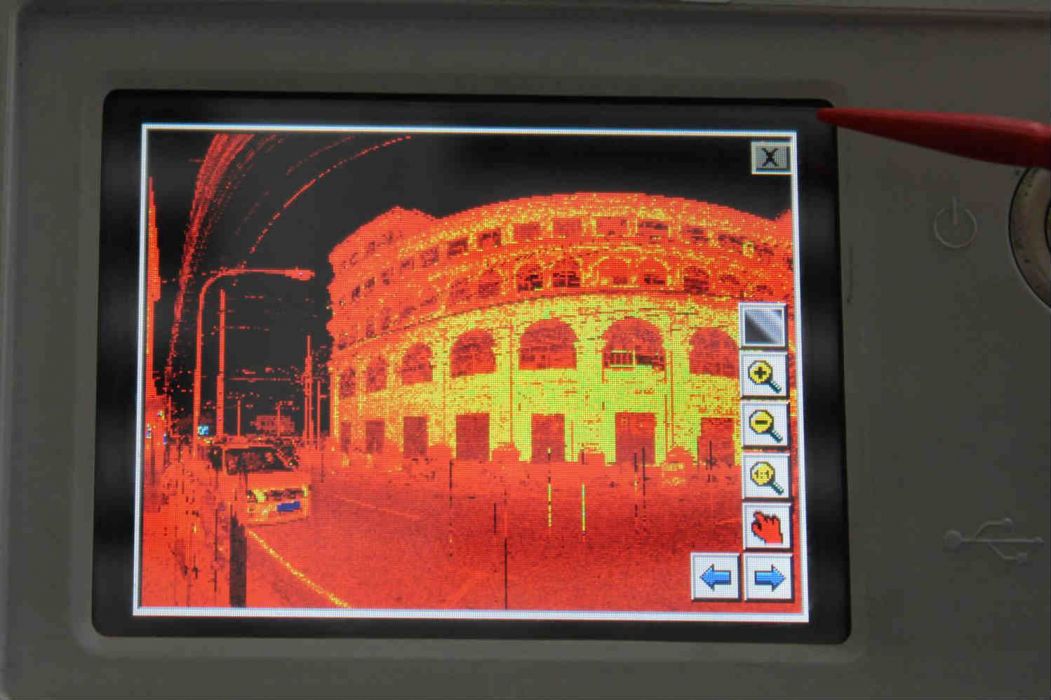A handful of people gathered outside the endangered El Hogar building in Binondo on Sunday afternoon to talk shop and admire the Beaux-Arts style of the abandoned building. There was Ivan Man Dy of Old Manila Walks, a tour agency that has been giving walking tours in Binondo since 2005, journalist Sol Vanzi, The Urban Roamer blog owner Karl Aguilar, Isidra Reyes of Facebook Page Manila Nostalgia, Chito Reambonanza of Facebook Group Memories of Old Manila, Chiqui Sy-Quia Mabanta, and more. No one among them has a personal recollection of being inside El Hogar but they were all concerned that it shouldn’t be demolished.
3D AS-BUILT LASER SCAN DOCUMENTATION OF EL HOGAR BY DIGISCRIPT
El Hogar was built in 1914 by Don Antonio Melian as a wedding present to his wife Margarita Zobel (of the Zobel de Ayala clan). Melian was a Spaniard born in Las Palmas, former capital city of Canary Island, who earned his bachelor arts degree from San Isidro Institute in Madrid. He set foot in Manila in 1907 and on the same year met and married Margarita, daughter of Manila mayor Jacobo Zobel y Zangroniz, at San Agustin Church. The Excelsior, a local magazine, gave it a six-page coverage.
According to tour guide and Coconuts Manila contributor Anson Yu, when El Hogar opened in December 1914, the magazine Dia Filipina proclaimed the three-and-a-half-story structure as the best of its kind in Asia.
It was one of the first buildings in Manila to be built entirely out of concrete. Because of this distinction, it attracted tenants like Eastern Extension Cable Co, Commercial Pacific Cable Co, shipping firm Smith, Bell and Co and Melian’s own insurance firm, Filipinas Compania de Seguros.
These days, it is but a shadow of its former self.

No to demolition: El Hogar’s staunch defenders at the event ‘Sign, Save, Scan El Hogar’ on Nov 9, 2014. Top: Digiscript’s machine documents the building using an expensive laser scanning technology.
Until early this year the building still had tenants who used El Hogar as a business address. They were asked to vacate in February as the building was turned over to its new owner — whose identity is still unknown.
“These are the things we know,” reveals Clara Buenconsejo, member of the Heritage Conservation Society youth chapter, who co-ordinated the Sunday meeting called “Sign, Save, Scan El Hogar”. “The contractor is NGCB (New Golden City Builders & Development Corporation) which has been linked to Megaworld — but Megaworld has issued a statement that they are not affiliated in any way with the project. Sila nga daw yung natalo sa sale nitong El Hogar.”
The advocacy group also knows the name of the security agency, Golden Diamond, but when they approached the security guard stationed at El Hogar, he claimed to not know who the building’s owner is. “Naintindihan mo naman na baka mawalan pa ng trabaho si kuya, kaya hindi na namin hinassle,” adds Buenconsejo.
She later brought our group to the top floor of Juan Luna E-Services right across the street, to see the width and breadth of El Hogar. The weather was pleasant, not too hot, and the Pasig River was clean, for a change. Someone pointed out the tin roof that extends beyond El Hogar’s concrete structure. That, he said, is the courtyard. It’s supposed to help keep the air moving in and out of the building.

The unphotographed El Hogar courtyard is covered from view by a tin roof.
The seven-storey Juan Luna E-Services building is everything that El Hogar could become. Built in 1922, at an adjacent lot, it was recently restored and outfitted with an elevator.
Unfortunately, it still has no tenants.
One of the issues cited by prospective lessees is security — it is located on the farthest end of Juan Luna Street, right by the Pasig River, where several barges are moored and informal settlements are aplently. The original plan was to turn this — and other historic buildings in the area — into a call center. On our visit, we were told that an architectural firm is looking at leasing the penthouse level.
The building’s top floor was the last stop for Conrad Alampay, president of Digiscript, a company that offers “as-built” documentation of a building using an expensive laser scanning technology. It’s high-definition surveying.
“For old buildings that don’t have records anymore, we come in and create documentations and blueprints, because those blueprints are critical for any renovation plan or restoration. You need the measurements of everything about the building before you do any work or redesign,” he explains. “With this system we can now capture and preserve forever the dimensions of the building as it stands today. So all windows, doors, measurements from the outside.”

El Hogar on the corner of Muelle dela Industria and Juan Luna Street faces the Pasig River. Despite broken glass windows and decay, it still looks majestic.
Earlier in the day, while the rest of us took photos of El Hogar at every angle concievable, Alampay and his team were quietly moving around what looked like an industrial-sized Leica camera, stopping at different sections of the road, taking in every detail of the building.
His company is offering this service free of charge. It’s just one of their pro bono works for heritage sites. They did the same for Manila Cathedral, which was recently restored, and that project could easily have cost PHP500,000. Digiscript has also done work for San Sebastian Basilica, the war tunnel in Fort Bonifacio and the dungeon in Fort Santiago.
He adds: “Why we came in today is to safeguard and document what we can for El Hogar because we don’t know its fate weeks or years from now.”
Photos: James P. Ong except for first two photos from top by Jericho Carrillo
WATCH AN AERIAL VIEW OF EL HOGAR





